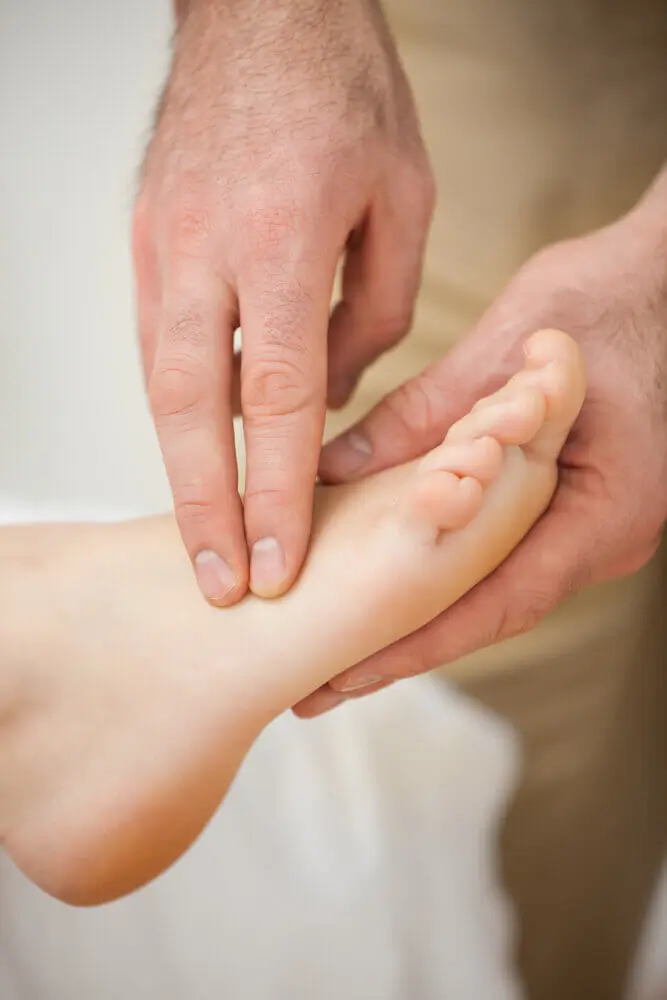Did you know that 80% of sinus tarsi pain cases start with a simple ankle sprain?
Sinus tarsi pain affects a small but significant space between your ankle bone and heel bone, turning normal activities into painful challenges. The condition might be uncommon, but its symptoms frequently mirror other ankle problems, making accurate diagnosis particularly tricky.
What does sinus tarsi pain feel like? Most patients describe a persistent aching sensation that intensifies during movement. This pain becomes notably sharper when bearing weight or changing direction while walking. The good news? Recognising proper symptoms and understanding treatment options significantly improves recovery outcomes.
Why should you learn about this condition? Sinus tarsi syndrome can severely limit your mobility when left untreated. This article explores the nature of sinus tarsi syndrome, what causes it, how to identify its symptoms, and most importantly, effective treatment approaches to help you find relief.
What Is Sinus Tarsi Syndrome?
What exactly happens in sinus tarsi syndrome? This condition specifically affects a small but critical space in your foot. Unlike general ankle pain, sinus tarsi syndrome targets a precise anatomical location with its unique symptoms and causes.
Anatomy of the sinus tarsi
Where is the sinus tarsi located? This tunnel-like space sits between your talus (ankle bone) and calcaneus (heel bone) on the outer side of your foot. Medical professionals often refer to it as the “eye of the foot” or “bullet hole.” Despite its small size, this cavity houses several vital structures including blood vessels, nerves, fat tissue, and important ligaments.
The sinus tarsi contains five key ligamentous structures: the intermediate, medial, and lateral roots of the inferior extensor retinaculum; the cervical ligament; and the interosseous talocalcaneal ligament. These components play crucial roles in ankle stability. The cervical ligament limits inversion (turning inward) while the interosseous talocalcaneal ligament controls eversion (turning outward).
Function of the subtalar joint
How does the subtalar joint work? This joint forms at the meeting point of your talus and calcaneus, creating what medical professionals classify as a synovial joint. Operating on an oblique axis, it serves as the primary site for inversion and eversion movements of the foot.
The subtalar joint allows your foot to adapt to uneven surfaces and accommodate varied terrain. It functions through a complex mechanical process, essentially acting as a mitred hinge between the talus and calcaneus. During normal walking, this joint performs two essential functions: absorbing shock when your heel strikes the ground and providing rigidity during push-off.
How sinus tarsi pain differs from other ankle pain
What makes sinus tarsi pain unique? The pain typically concentrates on the lateral (outer) side of the ankle, specifically in the hollow between the ankle bone and heel bone.
People suffering from this syndrome experience characteristic instability, particularly noticeable when walking on uneven ground. Unlike typical ankle sprains, pain from sinus tarsi syndrome:
- Intensifies after physical activity or walking on uneven surfaces
- Becomes worse with specific movements like turning the foot inward or outward
- Creates a feeling that the foot might give out during normal activities
Ankle sprains cause 70-80% of sinus tarsi syndrome cases, while the remaining 20-30% result from excessive foot pronation or flat feet. Understanding these distinctive features helps distinguish sinus tarsi syndrome from other ankle pain conditions such as arthritis, stress fractures, or tarsal tunnel syndrome.
Common Causes of Sinus Tarsi Pain
What triggers sinus tarsi syndrome? The underlying causes often determine how the condition develops and which treatment approach might work best. Recognising these root causes helps identify risk factors and prevent recurrence.
Ankle sprains and injuries
Traumatic ankle injuries stand as the primary trigger for sinus tarsi syndrome, accounting for approximately 70-80% of all cases. This typically follows an inversion ankle sprain—when your foot rolls outward away from your body’s midline. The mechanism stretches or damages the ligaments surrounding the sinus tarsi, leading to inflammation.
Are you at higher risk after multiple sprains? Absolutely. Individuals who repeatedly sprain the same ankle face a significantly higher risk. Damage from multiple sprains creates chronic instability in the subtalar joint, allowing excessive movement that irritates the synovial lining. Those participating in sports requiring sudden direction changes (soccer, basketball, hockey) are particularly vulnerable to these injuries.
Flat feet and overpronation
People with flat arches form the second most common group affected by this condition, representing about 20-30% of cases. When feet overpronate—roll inward excessively during walking or running—the sinus tarsi space narrows.
How does this cause pain? The narrowing compresses soft tissues within that small cavity, triggering pain and inflammation. This pressure becomes especially problematic because the subtalar joint already experiences increased forces with flat foot posture. Pregnant women face higher risk due to increased pronation during pregnancy.
Overuse and repetitive stress
Can everyday activities cause sinus tarsi syndrome? Yes, beyond acute injuries, this condition commonly develops through repeated stress. Activities requiring substantial time standing on hard surfaces place persistent pressure on this vulnerable area. Rapidly increasing walking or running volume without proper adaptation can similarly overwhelm these structures.
Athletes in jumping sports face distinct risks through a mechanism called “whiplash injury”. This occurs when the talus moves anteriorly over the calcaneus during abrupt landings, creating shearing forces through the sinus tarsi. Cutting movements on firm surfaces particularly stress the joint, forcing it to the extremes of motion.
Recognising Sinus Tarsi Syndrome Symptoms
How can you identify sinus tarsi syndrome? Early symptom recognition offers the best chance for effective treatment. This condition presents with distinctive signs that differentiate it from other ankle problems.
Pain location and characteristics
Where does it hurt most? The hallmark of sinus tarsi syndrome is localised pain on the lateral (outer) side of the foot, specifically in the hollow area between your ankle bone and heel bone. Patients typically describe it as a constant ache that becomes sharper or stabbing when moving or bearing weight. The pain notably worsens when:
- Turning your foot toward or away from the center of your body
- Putting weight on it while walking, running, or climbing stairs
- Touching or pressing the sinus tarsi area
Does activity affect the pain? For many sufferers, the discomfort intensifies after prolonged activity or when walking on uneven terrain. Some patients report burning, numbness, or tingling sensations if nerves within the sinus tarsi become compressed.
Instability when walking
Why does your ankle feel unreliable? Functional instability represents another defining symptom of this condition. Patients generally describe a feeling that their foot might “give out” during normal activities. This sensation becomes particularly evident when:
- Walking over uneven ground, such as rocks or grass
- Stepping off a curb
- Running or sprinting
The sinus tarsi contains structures crucial for proprioception (your body’s awareness of position), so damage to this area often results in difficulty maintaining balance or stability, especially on irregular surfaces.
Swelling and tenderness
What visible signs might appear? Upon examination, visible swelling frequently appears in the space between the ankle and heel bones. In some cases, this swelling can become pronounced enough to be mistaken for a cyst or tumour. The area exhibits marked tenderness when pressed, and physicians can typically reproduce the pain by:
- Applying pressure directly to the sinus tarsi
- Forcing the foot into inversion or eversion movements
- Having the patient bear weight
Can symptoms appear later after an injury? Yes. Interestingly, symptoms might not appear immediately following an initial ankle injury, as the synovitis and fibrotic tissues associated with this syndrome take time to develop.
Diagnosis and Assessment Methods
How do podiatrists diagnose sinus tarsi syndrome? This condition requires a methodical diagnostic approach, as it often mimics other foot and ankle problems. Accurate identification proves crucial for effective treatment planning.
Physical examination techniques
What happens during the initial assessment? The diagnostic process typically begins with a comprehensive physical examination. Doctors locate tenderness precisely in the sinus tarsi area—the small hollow between the talus and calcaneus. Pain reproduction through specific movements often confirms suspicions; in particular, rotating the foot outward while applying pressure to the sinus tarsi area. The doctor might also assess subtalar joint stability using medial and lateral glides, moving the calcaneus over a stabilised talus.
The injection test serves as a highly reliable diagnostic indicator. When pain stops following the injection of local anesthetic into the sinus tarsi, it strongly suggests sinus tarsi syndrome. This method cleverly serves both diagnostic and therapeutic purposes.
Imaging tests (MRI, CT scan, X-ray)
Which imaging tests help confirm the diagnosis? While physical examination provides valuable information, imaging tests offer definitive confirmation. Among these options:
- X-rays help rule out fractures but typically appear normal in sinus tarsi syndrome cases. They primarily identify bone-related issues rather than soft-tissue inflammation.
- CT scans provide detailed bone structure visualisation, useful for excluding fractures or identifying hindfoot malalignment.
- MRI stands as the gold standard for sinus tarsi evaluation. It reveals inflammation, ligament damage, and fibrotic changes within the space. The most distinctive MRI finding is an increased signal on T2-weighted images in the sinus tarsi region, representing inflammatory cells replacing normal fat tissue.
Differential diagnosis from similar conditions
Could your pain be something else? Several conditions present with symptoms resembling sinus tarsi syndrome. These include:
- Foot and ankle arthritis
- Calcaneal stress fractures
- Talus fractures
- Tarsal tunnel syndrome
What makes sinus tarsi syndrome distinct? The specific location of pain, the sensation of instability on uneven surfaces, and the positive response to local anesthetic injection primarily distinguish this condition. Additionally, symptoms that worsen when walking on uneven ground or during specific ankle movements point toward sinus tarsi syndrome rather than alternatives. Your healthcare provider will carefully assess all symptoms before confirming the diagnosis.
Conclusion
Sinus tarsi syndrome presents unique challenges for both patients and practitioners. Understanding this condition thoroughly helps distinguish it from other ankle problems, leading to more targeted and effective treatment approaches.
Why is early detection so important? Recognising warning signs promptly becomes crucial for managing this condition effectively. Pain concentrated on the outer ankle area, combined with instability while walking and visible swelling should prompt you to seek medical attention without delay.
How are accurate diagnoses made? Proper diagnosis through thorough physical examination and appropriate imaging proves essential for developing targeted treatment plans. Medical professionals employ various diagnostic tools, from hands-on assessment to advanced imaging techniques like MRI, ensuring precise identification of the condition.
Sinus tarsi pain significantly impacts daily activities and quality of life. If you’re experiencing pain or discomfort in your feet, ankles, knees, back or lower limbs, book a podiatry appointment today. Our experienced team provides quality podiatry care using the latest assessments, technology, and techniques.
Remember, early intervention and professional guidance offer the best path toward recovery and preventing future complications. Through proper understanding, diagnosis, and treatment, you can work toward regaining mobility and returning to normal activities.




